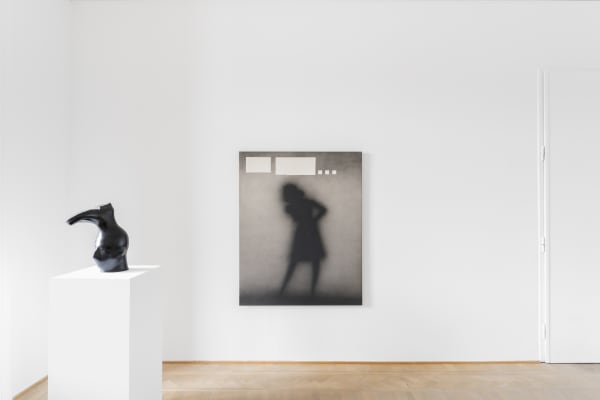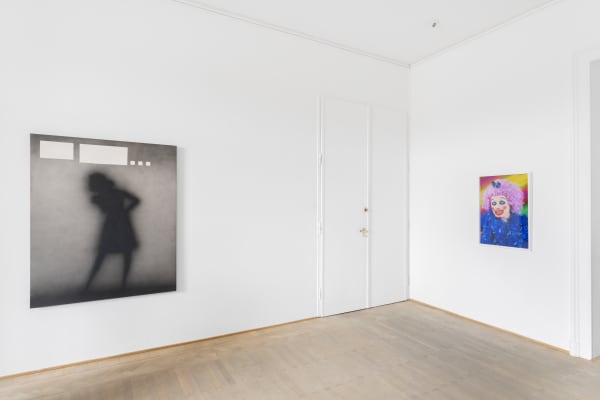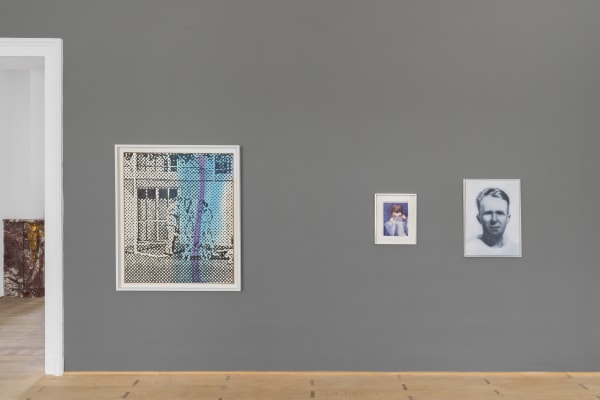Around the Figure
Vedovi Gallery is pleased to present Around the Figure, a group exhibition of paintings, sculptures, and photographs investigating the reconfiguration and transformation of the human figure from the mid-twentieth century up to the pre- sent days. Artists on view include Francis Bacon, Maurizio Cattelan, George Condo, Elisabeth Peyton, Sigmar Polke, Gerhard Richter, Daniel Richter, Thomas Ruff, Ed Ruscha, Andy Warhol and Tom Wesselmann.
The exhibition attempts to trace artistic practices that explore the body in transformative states of exposure and concealment. Moving between abstraction and figuration, portraiture and self-portraiture, the seminal artists on view ask whether our bodies really do belong to ourselves; a question that, in the present era of social media, facial recognition, and “deep fakes”, is more pertinent than ever.
The post-war era found the human body newly in flux. Wartime visions of strength and resilience had been superse- ded by trauma and austerity, even as consumerism, with its sexualization of buying power, was flourishing. Opposing visions of bodily liberation — girded by the concurrent rise of the Second-Wave Feminism and the Sexual Liberation Movement — brought with them notions of a freed female body.
Western art history abounds with images of reclining female nudes, but in the nascent days of American Pop Art, Wesselmann’s subject’s seductive horizontal position mirrors the flattening of high and low culture. Great American Nude #25 (1962), the earliest work in the exhibition, offers an intriguing entry-point into this exploration of the dema- terialisation of the human body through metamorphic acts. Forty years later, Thomas Ruff would premiere his Nudes series (dg08, 2002). Just as Wesselmann had culled images of the sexualised female form from popular culture, here Ruff scoured internet pornography and then manipulated the images, warping, pixilating, and softening the images into cinematic tableaux, at once strengthening and threatening the collapse of their allure.
On the other hand, Andy Warhol’s glamorisation of American culture and self-image, as seen in Self portrait (1967), reveals the artist’s self-consciousness through deliberate over-exposure, smoothing and generalising his image. In his prescient understanding of self-commoditisation, Warhol’s self-portraits hauntingly anticipate our current selfie-ob- sessed state, in which the increasing control exerted over the representation of one’s features is divorced from one’s true emotional state. In Maurizio Cattelan’s surreal self-portrait Untitled (2009), meanwhile, the artist’s likeness is trapped in a black rubber military boot, at once referencing institutional hierarchies and suffocating abuses of power in post-Fascist Italy. We are left to ask, is the artist being smothered, or smothering himself?
We similarly find the portraiture of George Condo, Gerhard Richter, and Elizabeth Peyton in confrontation with notions of control and concealment. Craig (1996) is a study in intimacy, in which the beautiful, young, and famous subject of Peyton’s portrait gradually reveals himself to an audience by what he coyly attempts to hide. Richter’s Study for 324 (Thomas Edward Lawrence) (1971), meanwhile, toys with the distance of memory: a candid moment in the life of Lawrence in Arabia, once again softened and isolated through a process of zooming in, is caught as if in the mind’s eye. George Condo’s The Linden Boy further echoes this unplaceable nostalgia with the pristine depiction of a young boy in gold-plated bronze, his enigmatic features smoothed and polished into a state of heady idealisation.
A counterpoint to these agitated states of control and memory can be found in Francis Bacon’s Untitled - Head (1967). Painted at the height of his exploration into portraiture, the work is a cancellation of figurative representation, instead depicting a subject in flux, his features grotesquely wiped away as if we are witnessing emotions shifting in real time. The theme of erasure continues in Ed Ruscha’s I’m Lost... (1995) in which blank thought bubbles wade over the contrapposto silhouette of a mid-century woman amidst a grey ether, and in Sigmar Polke’s Untitled (667) (1994), in which a heavily rasterised image of three figures in conference is struck through by washes of blue and purple. In Daniel Richter’s Punktum (2003), meanwhile, a crowd of Richter’s characteristic glowing figures are gripped by a spectacle of manifestation or disappearance, unsure whether to be dazzled or horrified by the magical act they are witnessing
These works bear witness to the masks we as humans wear to guard interior states of being, and the tension between a desire to reveal one’s true self and the impulse to remain impenetrable to the gaze of others.














